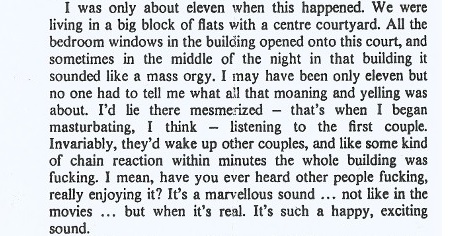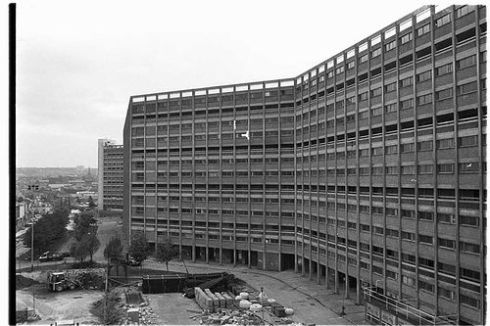
Sheffield: Sex City (B-side to ‘Babies’, 1992)
Sheffield: Sex City (instrumental)
Sheffield: Sex City (live film, The Warehouse, ITV, 1993)
Sheffield Sex City (live film, Brixton O2 Academy 01/09/2011)
Sheffield: Sex City (Teatro La Cúpula, Santiago, Chile, 2012)
Sheffield: Sex City at Pulpwiki
“At the age of twenty-two, newly graduated and without a clear plan in life, I moved to Sheffield. It wasn’t a city I knew well, and there was no particular reason to move there other than that I knew someone with a room to spare. I was also a big fan of the band Pulp, and their song Sheffield: Sex City had led me to believe that the city held a promise of sorts.” Jon McGregor – ‘On Pulp, Sheffield, and learning a trade’
Sheffield is like another woman, a soft umbrella under which all his stories play out. Sheffield is all encompassing, taunting cheekily, inviting us out or telling us to stay in. I wanted to be there when I heard this song, so I moved there! – Kate Jackson of The Long Blondes in The Guardian
“When I was 16, I and my girlfriend were completely obsessed by this song, and we walked around willing ourselves to see the teeming, simmering, carnal city described, peering into the L-shaped windows of the tower blocks, past the twitching curtains of the semis, imagining the couplings and perversions inside.” – Owen Hatherley, ‘Uncommon’
“The morning after My Legendary Girlfriend. Trying to get things done but ending up on a tour round the fleshpots of Sheffield in a T-reg Chevette. Wybourn, Brincliffe, Intake – All these places really exist and maybe these adventures still happen there – I wouldn’t know; I don’t live there anymore.” – Original sleeve notes
It sounds like a terrible idea. A misfit northerner gasping and groaning his way through an eroticised description of his hometown over an electro-funk backing? The keyboard player reading a section from a book of erotic fantasies in a flat Sheffield accent? Experimental sound & stereo production? An eight-and-a-half-minute-long b-side with no chorus? What could lead professional musicians to embark on such a folly?
In reality, though, we all know Sheffield: Sex city is nothing short of monumental. Since you’re reading this I expect it means as much to you as it does to those quoted above – I know it does for me – and if it weren’t for the after-the-watershed content and the running time I think we all know it would be as well-known as ‘Babies’ or ‘Do you Remember The First Time?’. Somehow, though, it’s even more than that. It’s a song that deserves to have a time and a place associated with it, or even better a film – A night in Sheffield, as directed by Antonioni or Żuławski – and even then it would be simply too big. It inspires not only dreams, but art, literature, life decisions. In only one way is it disappointing; after dreaming so big, all that’s left is the comedown.*
For a dream, though, S:SC can seem awfully brutal at times. At its darkest the song seems like a partial re-write of Blue Glow, in which the very buildings seemed like enemies or traps, mazes to become lost in. Sheffield is out to get him – primarily by erecting barriers – walls – between people who could otherwise join together to break this artificial alienation. There are also echoes of This House Is Condemned – the narrator is “sentenced to three years in the housing benefit waiting room.” This Sheffield is looming and oppressive, the home of the darkness of the 1980s, the place he had to escape.
These moments are little more than shards of memory, though. If the song has an overarching narrative it’s constructed in a dream logic. Perspectives continually shift, little threads of half-remembered detail keep weaving through. “The fares went up at 7” refers to the famous pricing policy of Sheffield busses, but in context it makes as much sense as someone babbling in their sleep. These fragments of narrative add to the feel of a sweeping overview – are these the same characters or just vignettes of a city with a thousand stories?
In some ways you could be forgiven for feeling the city is being mocked; even the title itself is a parody of the “Steel City” slogan. The listing of districts sounds like an imitation of advertisements for new estates in the 50s and 60s, when places like Park Hill and Kelvin were a physical representation of the future – “streets in the sky”. By the 1990s, of course, these developments were poorly maintained and regarded by many (not all of course, park Hill his now listed and renovated) as a sad indictment of the city’s decline. It would be tempting to think, then, that the Proustian sensory experiences of S:SC are some kind of joke, but if they are then the joke is played so straight that there’s no choice but to take it seriously.
Jarvis could never have written S:SC while he remained in in his hometown. The dream-picture of the city is from the nostalgic viewpoint of an expat or an exile. Most of the group still remained in Sheffield, and it must have been odd for them to have this sudden shift in perspective. A place you live in is the background hum in your head – you tune it out, and only notice it when it’s gone. Some things can only be viewed clearly, then, from outside – the exotic, the familiar, the eternally unknowable. Sheffield is a woman, a lost love, and S:SC is a dirty love letter to her. At times this is even physically represented – in one enduring image he actually “makes love to a crack in the pavement” – but on the whole the femininity of the city is present in its very spaces. The sexualised city is at once a physical place and one that lives in people. The derelict factories, the dead, sterile new estates are in fact living and sentient, teeming with people, all with their own stories, but all part of one greater entity. At times you can feel the weight of this, the oppression of Blue Glow or Being Followed Home, but when this entity is a friend the physical spaces become a vast playground for the lovers, and their actions are amplified so much that passion and orgasm are converted into destruction, collapsing buildings, the whole street dying of lung cancer. How could it not?
As an improvised piece of spoken word on top of an instrumental track, Jarvis’s performance here exceeds any reasonable expectations, sounding at times tormented, flirty, pathetic, lost and ecstatic. Ed Buller’s production helps, of course, most importantly in bringing the mic so close that it sounds (especially at the start) that he’s whispering in your ear.
This is hardly a one-man show, however – the track was a jam at first, and the fact that the Babies single also included an instrumental mix demonstrates that the words were essentially an afterthought. In a way you could say that the track is Candida’s finest moment – as well as taking a lead with her Ray Manzarek plays Stereolab keyboards, she joins in with a reading from a book of women’s erotic fantasies compiled by Nancy Friday.

So convincingly deadpan is the reading that you naturally imagine she’s recounting her own experience of living in a concrete tower-block looking out onto a thousand identical windows, wondering what was going on behind the curtains. Never the most outgoing of people, Candida seems to have been too embarrassed to perform this live, and it was therefore cut out (in the 90s) or replicated with a recording (on the reunion tour). Later on she joins Jarvis on a call-and-response section around the stereo space – I don’t have a lot to say about this, but it’s wonderful nonetheless.
Steve Mackey – that other exile from the North – plays an important role here too, his steady bassline brought down to a throbbing sub-woofer heartbeat by Warp’s in-house producer Zebedee. The production throughout is refreshingly minimal – Buller adding as few layers as possible in order to produce a meandering live feel to replicate the meandering dream-like narrative. Nick is somewhere out there, continuing discreetly, while Russell’s violin is only audible at certain moments, and is used essentially as a condiment, sparingly.
As a representation of what Pulp were, what they could do, what they could say, Sheffield: Sex City works as well as anything else they’ve done – perhaps even more-so, as you couldn’t imagine anyone else producing anything like this.
“There are eight million stories in the Naked City. This has been one of them.” – Closing narration to Naked City
*As a corollary of that, I have a question; how can the creators of this have not gone on to create astounding books or films? The only obvious thing to blame is the comfort zone people find themselves in when the struggle to make yourself heard is finished and won. Still, as much fun as Jarvis’s solo LPs and the Pulp reformations have been, I think we’re all a little disappointed that there hasn’t been more substantial work since 2002.
Tags: apocalyptic suburbia, babies single, dream logic, intro, jam, sex, sexualised city, sheffield, spoken word








